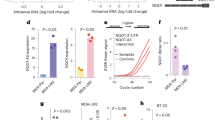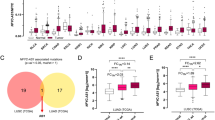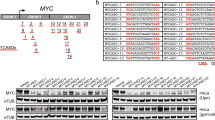Abstract
Identification of human disease-causing genes continues to be an intense area of research. While cloning of genes may lead to diagnostic tests, development of a cure requires an understanding of the gene's function in both normal and diseased cells. Thus, there exists a need for a reproducible and simple method to elucidate gene function. We evaluate C-5 propyne pyrimidine modified phosphorothioate antisense oligonucleotides (ONs) targeted against two human cell cycle proteins that are aberrantly expressed in breast cancer: p34cdc2 kinase and cyclin B1. Dose-dependent, sequence-specific, and gene-specific inhibition of both proteins was achieved at nanomolar concentrations of ONs in normal and breast cancer cells. Precise binding of the antisense ONs to their target RNA was absolutely required for antisense activity. Four or six base-mismatched ONs eliminated antisense activity confirming the sequence specificity of the antisense ONs. Antisense inhibition of p34cdc2 kinase resulted in a significant accumulation of cells in the Gap2/mitosis phase of the cell cycle in normal cells, but caused little effect on cell cycle progression in breast cancer cells. These data demonstrate the potency, specificity, and utility of C-5 propyne modified antisense ONs as biological tools and illustrate the redundancy of cell cycle protein function that can occur in cancer cells.
This is a preview of subscription content, access via your institution
Access options
Subscribe to this journal
Receive 12 print issues and online access
$209.00 per year
only $17.42 per issue
Buy this article
- Purchase on Springer Link
- Instant access to full article PDF
Prices may be subject to local taxes which are calculated during checkout
Similar content being viewed by others
References
Milligan, J.F., Matteucci, M.D. and Martin, J.C. 1993. Current concepts in anti-sense drug design. J. Med. Chem. 36: 1923–1937.
Stein, C.A. and Cheng, Y.-C. 1993. Antisense oligonucleotides as therapeutic agents—is the bullet really magical? Science 261: 1004–1012.
Wagner, R.W. 1994. Gene inhibition using antisense oligodeoxynucleotides. Nature 372: 333–335.
Wagner, R.W. 1995. Toward a broad-based antisense technology. Antisense Res. and Dev. 5: 113–114.
Nurse, P. 1994. Ordering S phase and M phase in the cell cycle. Cell 79: 547–550.
Sherr, C.J. 1994. G1 phase progression: cycling on cue. Cell 79: 551–555.
Heichman, K.A. and Roberts, J.M. 1994. Rules to replicate by. Cell 79: 557–562.
King, R.W., Jackson, P.K. and Kirshner, M.W. 1994. Mitosis in transition. Cell 79: 563–571.
Norbury, C. and Nurse, P. 1992. Animal cell cycles and their control. Ann. Rev. Biochem. 61: 441–470.
Pines, J. and Hunter, T. 1990. Isolation of a human cyclin mRNA and protein regulation in the cell cycle and for interaction with p34cdc2 . Cell 58: 833–846.
Kumagai, A. and Dunphy, W.G. 1991. The cdc25 protein controls tyrosine dephos-phorylation of the cdc2 protein in a cell-free system. Cell 64: 903–914.
Gautier, J., Solomon, M.J., Booher, R.N., Bazan, J.F. and Kirschner, M.W. 1991. Cdc25 is a specific tyrosine phosphatase that directly activates p34cdc2 . Cell 67: 197–211.
Desai, D., Gu, Y. and Morgan, D.O. 1992. Activation of human cyclin-dependent kinases in vitro. Molec. Biol. Cell 3: 571–582.
Fisher, T.L., Terhorst, T., Cao, X. and Wagner, R.W. 1993. Intracellular disposition and metabolism of fluorescently-labeled unmodified and modified oligonucleotides microinjected into mammalian cells. Nucl. Acids Res. 21: 3857–3865.
Th'ng, J.P.H., Wright, P.S., Hamaguchi, J., Lee, M.G., Norbury, C.J., Nurse, P. et al. 1990. The FT210 cell line is a mouse G2 phase mutant with a temperature-sensitive CDC2 gene product. Cell 63: 313–324.
Riabowol, K., Draetta, G., Brizuela, L., Vandre, D. and Beach, D. 1989. The cdc2 kinase is a nuclear protein that is essential for mitosis in mammalian cells. Cell 57: 393–401.
van den Heuvel, S. and Harlow, E. 1993. Distinct roles for cyclin-dependent kinases in cell cycle control. Science 262: 2050–2054.
Furukawa, Y., Piwnica-Worms, H., Ernst, T.J., Kanakura, Y. and Griffin, J.D. 1990. Cdc2 gene expression at the G1 to S transition in human T lymphocytes. Science 250: 805–808.
Shaw, J.P., Kent, K., Bird, J., Fishback, J. and Froehler, B. 1991. Modified deoxy-oligonucleotides stable to exonuclease degradation in serum. Nucl. Acids Res. 19: 747–750.
Welch, P.J. and Wang, J.Y.J. 1992. Coordinated synthesis and degradation of cdc2 in the mammalian cell cycle. Proc. Natl. Acad. Sci. USA 89: 3093–3097.
Stein, C.A. and Krieg, A.M. 1994. Problems in interpretation of data derived from in vitro and in vivo use of antisense oligodeoxynucleotides. Antisense Res. Dev. 4: 67–69.
Mouthon, M.A., Mitjavila, M.T., Marquet, J., Vainchenker, W. and Wendling, F. 1994. Erroneous results of 3H-thymidine incorporation are related to position of thymidine residues in oligodeoxynucleotides. Exp. Hematol. 22: 384–387.
Barton, C.M. and Lemoine, N.R. 1995. Antisense oligonucleotides directed against p53 have antiproliferative effects unrelated to effects on p53 expression. Brit. J. Cancer 71: 429–437.
Krieg, A.M., Yi, A.K., Matson, S., Waldschmidt, T.J., Bishop, G.A., Teasdale, R. et al. 1995. CpG motifs in bacterial DNA trigger direct B-cell activation. Nature 374: 546–549.
Morishita, R., Gibbons, G.H., Ellison, K.E., Nakajima, M., von der Leyen, H., Zhang, L., et al. 1994. Intimal hyperplasia after vascular injury is inhibited by anti-sense cdk 2 kinase oligonucleotides. J. Clin. Invest. 93: 1458–1464.
Morishita, R., Gibbons, G.H., Ellison, K.E., Nakajima, M., Zhang, L., Kaneda, Y. et al. 1993. Single intraluminal delivery of antisense cdc2 kinase and proliferat-ing-cell nuclear antigen oligonucleotides results in chronic inhibition of neointimal hyperplasia. Proc Natl. Acad. Sci. USA 90: 8474–8478.
Vesely, J., Havlicek, L., Stinad, M., Blow, J., Donnela-Deana, A., Pinna, L. et al. 1994. Inhibition of cyclin-dependent kinases by purine analogues. Eur. J. Biochem. 224: 771–786.
Hanvey, J.C., Peffer, N.J., Bisi, J.E., Thomason, S.A., Cadilla, R., Josey, J.A. et al. 1992. Antisense and antigene properties of peptide nucleic acids. Science 258: 1481–1485.
Wagner, R.W., Matteucci, M.D., Lewis, J.G., Gutierrez, A.J., Moulds, C. and Froehler, B.C. 1993. Antisense gene inhibition by oligonucleotides containing C-5 propyne pyrimidines. Science 260: 1510–1513.
Bennett, C.F., Chiang, M.Y., Chan, H., Shoemaker, J.E. and Mirabelli, C.K. 1992. Cationic lipids enhance cellular uptake and activity of phosphorothioate anti-sense oligonucleotides. Mol. Pharmacol. 41: 1023–1033.
Capaccioli, S., Di Pasquale, G., Mini, E., Mazzei, T. and Quattrone, A. 1993. Cationic lipids improve antisense oligonucleotide uptake and prevent degradation in cultured cells and in human serum. Biochem. Biophys. Res. Commun. 197: 818–825.
Lewis, J.G., Lin, K.Y., Kothavale, A., Flanagan, W.M., Matteucci, M.D., DePrince, R.B. et al. 1996. A serum-resistant cytofectin for cellular delivery of antisense oligonucleotides and plasmid DNA. Proc. Natl. Acad. Sci. USA 93: 1112–1116.
Moulds, C., Lewis, J.G., Froehler, B.C., Grant, D., Huang, T., Milligan, J.F. et al. 1995. Site and mechanism of antisense inhibition by C-5 propyne oligonucleotides. Biochemistry 34: 5044–5053.
Ohtsubo, M. and Roberts, J.M. 1993. Cyclin-dependent regulation of G1 in mammalian fibroblasts. Science 259: 1908–1912.
Koff, A., Giordano, A., Desai, D., Yamashita, K., Harper, J.W., Elledge, S. et al. 1992. Formation and activation of a cyclin E-cdk2 complex during the G1 phase of the human cell cycle. Science 257: 1689–1694.
Norbury, C., Blow, J. and Nurse, P. 1991. Regulatory phosphorylation of the p34cdc2 protein kinase in vertebrates. EMBO J. 10: 3321–3329.
Solomon, M.J., Lee, T. and Kirschner, M.W. 1992. Role of phosphorylation in p34cdc2 activation: Identification of an activating kinase. Mol. Biol. Cell 3: 13–27.
Fenster, S.D., Wagner, R.W., Froehler, B.C. and Chin, D.J. 1994. Inhibition of Human Immunodeficiency Virus type-1 env expression by C-5 propyne oligonucleotides specific for Rev Response element stem loop V. Biochemistry 33: 8391–8398.
Bennett, C.F., Condon, T.R., Grimm, S., Chan, H. and Chiang, M-Y. 1994. Inhibition of endothelial cell adhesion molecule expression with antisense oligonucleotides. J. Immunol. 152: 3530–3540.
Monia, B.P., Johnston, J.F., Ecker, D.J., Zounes, M.A., Lima, W.F. and Freier, S.M. 1992. Selective inhibition of mutant Ha-ras mRNA expression by antisense oligonucleotides. J. Biol. Chem. 267: 19954–19962.
Duroux, I., Godard, G., Boidot-Forget, M., Schwab, G., Helene, C. and Saison-Behmoaras, T. 1995. Rational design of point mutation-selective antisense DNA targeted to codon 12 of Ha-ras mRNA in human cells. Nucl. Acids Res. 23: 3411–3418.
Wagner, R.W., Matteucci, M.D., Grant, D., Huang, T. and Froehler, B.C. 1996. Potent and selective inhibition of gene expression by an antisense heptanucleotide. Nature Biotechnology 14: 840–844.
Monia, B.P., Lesnik, E.A., Gonzalez, C., Lima, W.F., McGee, D., Guinosso, C.J. et al. 1993. Evaulation of 2′-modified oligonucleotides containing 2′-deoxy gaps as antisense inhibitors of gene expression. J. Biol. Chem. 268: 14514–14522.
Larrouy, B., Boiziau, C., Sprout, B. and Toulme, J.J. 1995. RNase H is responsible for the non-specific inhibition of in vitro translation by 2′-O-alkyl chimeric oligonucleotides: high affinity or selectivity, a dilemma to design antisense oligomers. Nucleic Acids Res. 23: 3434–3440.
Giles, R.V., Ruddell, C.J., Spiller, D.G., Green, J.A. and Tidd, D.M. 1995. Single base discrimination for ribonuclease H-dependent antisense effects within intact human leukaemia cells. Nucleic Acids Res. 23: 954–961.
Keyomarsi, K. and Pardee, A.B. 1993. Redundant cyclin overexpression and gene amplification in breast cancer cells. Proc. Natl. Acad. Sci. USA 90: 1112–1116.
Hartwell, L.H. and Kastan, M.B. 1994. Cell cycle control and cancer. Science 266: 1821–1828.
Froehler, B.C. 1993. Protocols for oligonucleotides and analogs: synthesis and properties. Humana, Totowa, NJ.
Froehler, B.C., Wadwani, S., Terhorst, T.J. and Gerrard, S.R. 1992. Oligodeoxynucleotides ontaining C-5 propyne analogs of 2′-deoxyuridine and 2′-deoxycytidine. Tetrahedron Lett. 33: 5307–5310.
Froehler, B.C., Jones, R.J., Cao, X. and Terhorst, T.J. 1993. Oligonucleotides derived from 5-(1-propynyl)-2′-O-allyl-uridine and 5-(1-propynyl)-2′-O-allyl-cytidine: synthesis and RNA duplex formation. Tetrahedron Lett. 34: 1003–1006.
Bram, R.J., Hung, D.T., Martin, P.K., Schreiber, S.L. and Crabtree, G.R. 1993. Identification of the immunophilins capable of mediating inhibition of signal transduction by cyclosporin A and FK506: roles of calcineurin binding and cellular location. Mol. Cell. Biol. 13: 4760–4769.
Jackman, M., Firth, M. and Pines, J. 1995. Human cyclins B1 and B2 are localized to strikingly different structures: B1 to microtubules, B2 primarily to the Golgi apparatus. EMBO J. 14: 1646–1654.
Ausubel, P.M., Brent, R., Kingston, R.E., Morre, D.D., Seidman, J.G., Smith, J.A. and Struhl, K. (eds.). 1989. Current protocols in molecular biology. John Wiley and Sons, New York.
Quelle, D.E., Ashmun, R.A., Shurtleff, S.A., Kato, J.-Y., Bar-Sagi, D., Roussel, M.F. et al. 1993. Overexpression of mouse D-type cyclins accelerates G1 phase in rodent fibroblasts. Genes Dev. 7: 1559–1571.
Author information
Authors and Affiliations
Rights and permissions
About this article
Cite this article
Flanagan, W., Su, L. & Wagner, R. Elucidation of gene function using C-5 propyne antisense oligonucleotides. Nat Biotechnol 14, 1139–1145 (1996). https://doi.org/10.1038/nbt0996-1139
Received:
Accepted:
Issue Date:
DOI: https://doi.org/10.1038/nbt0996-1139
This article is cited by
-
Reversal of epidermal hyperproliferation in psoriasis by insulin-like growth factor I receptor antisense oligonucleotides
Nature Biotechnology (2000)
-
Cellular penetration and antisense activity by a phenoxazine-substituted heptanucleotide
Nature Biotechnology (1999)



